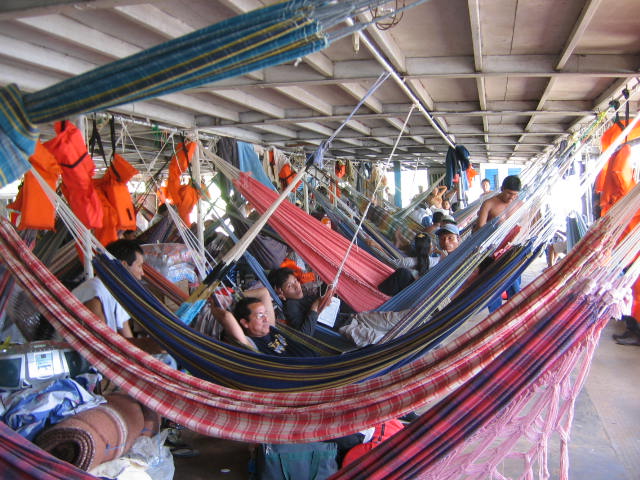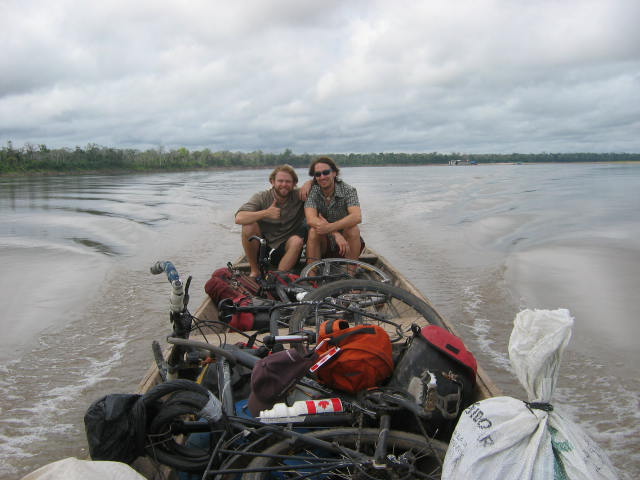Please visit Ryan Parton Writing Solutions, Comox Valley copy writer
The following are stories written for the Selkirk Journal and the Comox Valley Record during my 11-month bicycle expedition through South America, from January to November, 2004:
Border Bound (a pre-trip introduction)
Against the Wind Through Tierra del Fuego
Hurry Up and Slow Down (cycling in Patagonia)
Chugging Through Chile (cycling Chile's Carretera Austral)
Argentina a Lot Like Canada (crossing the Argentina pampas)
South America's Hidden Gem (travels in Uruguay)
The Bolivian Paradox
Pushing Through Peru (misadventures on a Peruvian riverboat)
Jungle Journey a Drag (cycling the Brazilian Amazon
Grand Finale (cycling Venezuela)
Back to my writing samples
Back to Atravesando Fronteras home page

 Pushing Through Peru
Pushing Through Peru
by Ryan Parton
Before embarking on what should have been a three-day journey down Peru´s Ucayali River, and not knowing exactly what to expect, I´d written in my journal that I´d simply hope for the best and expect the worst. Less that 24 hours later, however, it became painfully clear not only that my hopes had gone unanswered, but that “the worst” was much less bearable that I could have expected.
A month of cycling through Peru had brought Kris and I to the hot, dusty city of Pucallpa, on the western edge of the Amazon Basin. Pucallpa sits on the muddy banks of the Ucayali River, which we intended to follow some 800 kilometres north to the isolated jungle city of Iquitos, where its murky waters merge with those of the mighty Amazon itself.
I suppose our adventure began on Tuesday, the day we cycled down to Pucallpa´s dirty port, swarming with dark-skinned porters hauling nyon sacks on their sweaty shoulders, to board the “Mily,” scheduled to leave for Iquitos that evening. In four weeks of cycling through rural Peru, however, where things seem to operate with a frustrating sort of non-logic that makes George Bush´s peppery rhetoric seem downright enlightened, we´d failed to learn that a Peruvian schedule means little at best. The Mily wouldn´t be leaving until Wednesday.
The next day we once again set out for the port under the scorching mid-day sun, only this time we were allowed to board, by means of a network of narrow planks linking the Mily with the other boats between it and the shore.
A combination passenger/cargo ship called a “lancha,” the Mily was like most of the other boats docked in Pucallpa, although perhaps a touch smaller than most. Nonetheless, there was no way we could have known that it was the worst boat we could have boarded that day.
Our trip didn´t start off bad. We pulled out of Pucallpa at dusk, just as a briliant harvest moon was beginning to peek over the horizon, changing from orange to yellow to white as it climbed the evening sky. A cool breeze fanned our faces as we stood on the Mily´s top deck, watching the moonlight dance off the dark river and the distant shore slide silently by.
By morning, everything had changed.
We were greeted Thursday morning with the almost unbelievable news that we´d run aground during the night and were now mired in the muddy riverbed about 30 metres from shore. Nobody knew how or when we´d get ourselves unstuck, and nobody really seemed to care. Had this happened in Canada, people would have been complaining and demanding refunds, but here in Peru, where delays and mishaps are par for the course, our fellow travellers remained idling in their hammocks on the congested passenger deck, as if nothing were awry.
Our captain, a friendly man named Eleodoro who I´d more or less trusted up until then, told us that another boat would be by shortly to tow us out of our predicament. An hour passed, then two, and still we were alone. As we sat down for lunch, a gastronomic nightmare of chicken, rice and a plaintain cooked in river water, a large freighter finally appeared around the bend up ahead. Our spirits soared as it approached, like a lumbering steel angel of mercy, and then once again plummetted as we watched it sail right by.
 Stranded on a boat in the middle of the jungle with far too many people wtih no concept of personal space, I fled to the top deck to reflect on this latest development. As I sulked, I was mocked by the incessant squacking of parakeets in the treetops less than 100 metres away, laughing at our misfortune. Tormented by sandflies, and the oppressive afternoon heat, all I could do was wait.
Stranded on a boat in the middle of the jungle with far too many people wtih no concept of personal space, I fled to the top deck to reflect on this latest development. As I sulked, I was mocked by the incessant squacking of parakeets in the treetops less than 100 metres away, laughing at our misfortune. Tormented by sandflies, and the oppressive afternoon heat, all I could do was wait.
At around 4:00 a group of passengers, myself and Kris included, took matters into our own hands and began hauling 50-kilogram sacks of sugar from the back of the cargo hold to the front deck, hoping to lighten the Mily´s stern and help free us from the Ucayali´s muddy grasp. Having moved about 7,500 kilograms of sugar, we jumped into the shallow river and began pushing from the side as Eleodoro revved the giant diesel engine. The cappuccino-coloured water lapped at our chins as our feet slid deeper into the gooey muck beneath the Ucayali, but our efforts were rewarded as the Mily´s stern slowly inched free. After 15 hours stuck in the mud, we were once again on the move.
We enjoyed a full day of smooth sailing, during which I lazily watched pink dolphins slice throgh the water from the Mily´s front deck, before we were once again fingered by fate. Our engine died sometime during the night, and we drifted at the mercy of the strong current until finally running aground once again.
Although Captain Eleodoro again assured us that a boat was on its way to rescue us, Kris and I decided it was time to take charge of our own destiny. Donning our swim trunks, we leapt overboard and swam to a nearby sandbar, where we convinced a local fisherman to take us to the nearest village in his “peca peca,” a small wooden boat with a tiny outboard motor. The sense of relief was overwhelming as we fled the Mily, watching our stranded compatriots, still lounging complacently in their hammocks, fade into the distance.
The nearest village was San Cristóbal, little more than a handful of thatch-rooved huts amidst a cloud of sandflies, where we learned that the ship our captain had assured us was on its way was still docked in Pucallpa. Our only option for getting Kris to Lima in time for his Monday evening flight home was to board another lancha heading back to Pucallpa that afternoon.
For two more days we sailed upriver, arriving in Pucallpa early Monday morning. We then spent a hectic morning buying plane tickets and preparing for our flights, Kris´ to Lima and mine to Iquitos, from where I´d continue east into Brazil.
Before the clouds obscured my view as I gained altitude out of Pucallpa, I watched the once-large Ucayali snake through the endless forest below, like a microscopic image of some amoebic worm squiggling its way over a head of brocolli. Fifty-five minutes later, I´d accomplished what I couldn´t in five days: I´d made it to Iquitos.

Next
Previous
Border Bound (a pre-trip introduction)
Against the Wind Through Tierra del Fuego
Hurry Up and Slow Down (cycling in Patagonia)
Chugging Through Chile (cycling Chile's Carretera Austral)
Argentina a Lot Like Canada (crossing the Argentina pampas)
South America's Hidden Gem (travels in Uruguay)
The Bolivian Paradox
Pushing Through Peru (misadventures on a Peruvian riverboat)
Jungle Journey a Drag (cycling the Brazilian Amazon
Grand Finale (cycling Venezuela)
Back to my writing samples
Back to Atravesando Fronteras home page
 Stranded on a boat in the middle of the jungle with far too many people wtih no concept of personal space, I fled to the top deck to reflect on this latest development. As I sulked, I was mocked by the incessant squacking of parakeets in the treetops less than 100 metres away, laughing at our misfortune. Tormented by sandflies, and the oppressive afternoon heat, all I could do was wait.
Stranded on a boat in the middle of the jungle with far too many people wtih no concept of personal space, I fled to the top deck to reflect on this latest development. As I sulked, I was mocked by the incessant squacking of parakeets in the treetops less than 100 metres away, laughing at our misfortune. Tormented by sandflies, and the oppressive afternoon heat, all I could do was wait. Pushing Through Peru
Pushing Through Peru